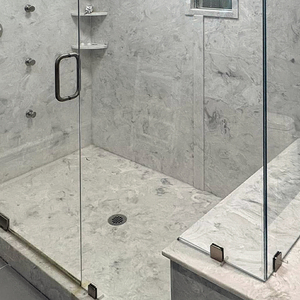I’m baffled! – Insulation help needed for addition project
I am adding on to my house, building up on top of a split level home with one room sticking out the back.
I am located in Lancaster county Pennsylvania.
I am installing mezzo triple pane windows with nail fin and integrated j channel and has U factor of 21 or 29 (sliding/double hung/picture).
I will install vinyl beaded siding on the walls, standing seam metal on front roof and rubber on back roofs
The roof sticks out past the walls about 2 feet on all sides
I am trying to build a structure that is extra energy efficient and takes less to heat and cool. I am trying to insulate it in a way that is cost-effective yet extra protective.
I am a Roofing Carpenter that has been around the various trades of remodeling/maintaining residential homes for 20 years, but I’m not trained on the specifics of insulating a structure.
I am installing 1 inch foil faced rigid foam 4‘ x 8’ sheets, on top of housewrap, that is on top of 7/16 plywood/OSB sheathing. I don’t like the idea of anything thicker on the outside, because it means the nails holding the vinyl siding will be more unsupported. And I’m trying to avoid installing additional lathe.
I am removing the siding and 1 inch fiber board from the exterior walls of the previously built walls (no wood sheathing!), removing the old batt insulation, adding 1.5” of wood to the 2×4 walls to match the addition exterior shell shape above and provide 5”cavity towards the 5.5” needed for the r 21, and installing new r21 batt insulation, then sheathing it with 7/16 osb and installing 1” foil faced insulation like the addition above.
I am having r 7 close cell spray foam installed on the interior side of all the new walls and ceilings. (Full foam on front sloped cathedral since it’s only 5.5”)
then installing r-21 unfaced batt insulation to the interior drywall
There are three levels being added, All with 2 x 6 framing. Two of the levels are the “attics”, that are basically trusses with rooms inside of them, meaning I have a 12 to 24 inch attic space above the ceiling on the back of the house (1 pitch rubber with 2.5” iso board, and 8 pitch 5.5” framing with cathedral on the front of the house (metal roofing)
I’ve added pictures and schematics, to help you visualize the project. The panoramic picture is from the one back corner to the other back corner showing the front, but not the back. Everything was done so that the existing rooms and ceilings were not disturb, and everything was built above that on a beam and column system that was designed by an engineer. Hopefully that is enough of a backstory to answer my following questions.
1. Do I need to vent my attic space at all? I was going to install baffles, but my Spray Foam contractor says that I don’t need them, plus I could fit more R-value if I don’t use them (do I need to do anything different for the eight pitch than I do for the two pitch?)
2. Do I need to install insulation under my metal roof (because of therma bridging of wood)? (I would use lathe and iso board if so)
3.1 Are my new walls safe from condensation?
3.2 Are my old walls safe from condensation with the new system?
i’ve been reading about thermal bridging and condensation. (maybe instead of lathing out the old walls with 1.5 inch lumber for more batt space, maybe I should just install 1.5 inch foam insulation instead, then OSB on top of that, then the 1 inch foil faced)
4. Do I need to install another layer of insulation on the outside? I’ve been reading that 11.25 R-value is recommended for zone six, and I would only have r 6.5, but does my r7 close cell spray foam applied on the inside of the wall help contribute to that total, since it’s separated by housewrap and sheathing?
5. Does installing unfaced insulation batts style makes sense, or is faced insulation better?
6. What heating or cooling system would you recommend? (I prefer not to do forced air, and I already have electric water radiant baseboard/floor heat for the old rooms , and a window unit/fans for cooling)
























Replies
Hi Jershammah,
Edit note: I removed my responses as I misinterpreted parts of your post. A lot of my comments were assuming you were talking about rigid insulation above your roof, and not on your exterior walls.
Please keep in mind with all of the following that I am far from an expert, this is just from the reading I have been doing for my own house where I am contemplating installing exterior rigid foam.
- Correct me if I'm wrong, but it sounds like you're installing around R 35 on the sloped ceiling of just spray foam? It sounds thin for an unvented setup. I believe you should be looking for R49, and skimping could cause ice dams down the road.
- My understanding is 11.25 is the minimum for exterior rigid insulation for your zone. Depending on what rigid you're using (I assume "foil faced" means polyiso?) you'll require more than 1" to hit it. If it is polyiso, be aware about cold temperature lowered R value. It can drop to R4 at lower temperatures, so you may require over 2" to hit that value.
- foil faced rigid on the exterior and closed cell spray foam on the interior is not great for moisture. They are two vapour barriers, and the "sandwiched" OSB won't have any way to dry if moisture is trapped
- your old walls sound safer as there's only a the rigid on the exterior and batt insulation inside. If anything bump your exterior rigid thicker and leave the 2x4s the same?
- my understanding of limiting moisture is that the higher the R value of the interior, the higher the exterior rigid insulation has to be as well. This is to keep the interior of exterior insulation "warm" so as to not cause condensation. Thin exterior insulation will likely fall below the dewpoint if it's only 1".
- if you have exterior rigid insulation which is a vapour barrier, your interior batts should be unfaced ideally. I believe the facing is a class II vapour barrier, which could lead to moisture issues.
Thank you for your comments. I talked to my Spray Foam contractor and he said he recommends 3 inches on the roof and 2 inches on the wall to be the recommended minimum to combat condensation. He said that 1 inch exterior and 1 inch interior spray foam added together can equal 2 inches needed. That being said, I know contractors don’t always fully understand the building science, they are just really good at doing the install itself, not fully understanding the exact theory behind it all.
This is all somewhat frustrating to me. The fact that I’m taking off fiberboard sheathing from my exterior walls, which is rated at R4, I would think that anything that I do would be better than what it was, but I do want to make sure that this is a great long-term project that I can pass on to my kids.
According to your comments, it sounds like you are recommending adding an additional layer of 2 inch insulation r7 (r4 in cold) on the exterior walls (r21 in summer and r12 in winter), and an additional 2 inches on the front roof (r38.5 + 14 = r52.5). Right?
The 5.5 rafters will be fully filled by me installing lathe first, by the way.
Hi Jershammah,
Again I preface all of this with the fact that this is just based off of the reading I have done, and you should defer to your professionals or others with more knowledge than me!
I understand your frustration as I have changed my insulation plan 3-4 times. I am in a similar climate with limited rafter space, so it's hard to find an ideal situation in order to attain those minimum values.
To address your points in order:
- I don't believe you can combine the spray foam and exterior rigid insulation towards that exterior R value. My understanding is that the 11.25 R value must be on the exterior of the sheathing as that's where the condensation will take place. You'll still only wind up with 1" on the exterior of the sheathing, which is where you'll see the most moisture damage. Maybe this won't be the case as the closed cell is a vapour barrier, so no moisture will actually reach the sheathing from the inside, but again you face the problem of the sheathing being unable to dry. If any moisture were to find it's way there it would have a hard time drying.
- if your previous setup for the walls was R4 fiberboard followed immediately by 2x4s (3.5" insulation), I would guess that you likely didn't have to worry about moisture as they weren't greatly insulated, so the fiberboard wasn't ever particularly cold. Likewise as the fiberboard didn't have a vapour barrier on the exterior of it, any moisture it accumulated could be readily shed. The rigid foam you're contemplating installing on the exterior wouldn't be able to do the same, and instead moisture would get stuck on the interior cavity.
- I am in no position to tell you exactly what values you are looking for as I am not knowledgeable enough in this field, but these are my takeaways: a) the higher percentage of rigid foam you have on the exterior the better, b) if you do exterior foam, make sure the inside cavity is filled with an air and vapour permeable insulation (cellulose batts/ fiberglass batts) c) if you don't have adequate space on the inside to correctly insulate, and you're still in the building phase, it's better now to install adequate rigid on the exterior than to have to worry about doing it later. You can also take that time to install a rain screen d) spraying closed cell spray foam is expensive. You can achieve better results at a lower cost with lower environmental impact using exterior polyiso and cellulose on the interior.
Again, this is all under the heavy disclaimer that this is just based off of the research I've been doing for my own house.
Take a look at these articles, defer to your professionals, and do what works best for you.
Calculating the minimum thickness of exterior rigid foam: https://www.greenbuildingadvisor.com/article/calculating-the-minimum-thickness-of-rigid-foam-sheathing
Combining exterior rigid foam with fluffy insulation: https://www.greenbuildingadvisor.com/article/combining-exterior-rigid-foam-with-fluffy-insulation
Thanks, I’m currently leaning towards installing one to 2 inches on top of my 1 inch foil face, skipping the foam insulation, and installing r 21 bats on the inside.
That would give me r 13 (2” total) to r 19.5 (3” total) on the outside, and r 21 on the inside.
Plus I would have the additional benefit of staggering the joints on the outside, since I already have the 1 inch installed!